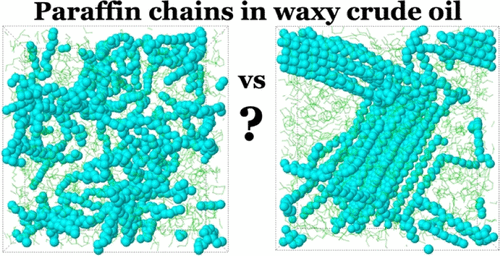Our official English website, www.x-mol.net, welcomes your
feedback! (Note: you will need to create a separate account there.)
Transport Properties of Waxy Crude Oil: A Molecular Dynamics Simulation Study.
ACS Omega ( IF 3.7 ) Pub Date : 2020-07-20 , DOI: 10.1021/acsomega.0c00070 Xuejiao Chen 1, 2 , Lei Hou 1 , Xiaoyu Wei 3 , Dmitry Bedrov 3
ACS Omega ( IF 3.7 ) Pub Date : 2020-07-20 , DOI: 10.1021/acsomega.0c00070 Xuejiao Chen 1, 2 , Lei Hou 1 , Xiaoyu Wei 3 , Dmitry Bedrov 3
Affiliation

|
To study the effects of paraffin on viscosity of waxy crude oil and transport properties of small molecules, light and waxy crude oil models were investigated at atmospheric pressure and 293–323 K temperature range using atomistic molecular dynamics simulations. The optimized parameters for liquid simulations all-atom (OPLS-AA) and atomistic polarizable potential for liquids, electrolytes, and polymers (APPLE&P) force fields were employed. The self-diffusion coefficients, viscosity, and paraffin configurations were compared for two oil models and between the two employed force fields. However, the behavior of paraffin molecules predicted by two force fields was quite different. Simulations using the OPLS-AA force field showed crystallization of longer paraffin molecules below 323 K, while simulations with the APPLE&P force field demonstrated a homogeneous mixture down to 293 K. To provide additional validation of the employed force fields, the density, diffusion coefficient, and crystallization of pure alkanes were compared with experimental data. The density and diffusion coefficients of n-C6 and n-C14 simulated with the APPLE&P force field were found to be in much closer agreement with the experimental data. The OPLS-AA force field was found to overestimate the crystallization temperature of pure alkanes. Therefore, simulations with the APPLE&P provide more realistic description of the waxy oil structure and transport properties. In this temperature range, the paraffin molecules are homogeneously distributed in the mixture, and viscosity of the system increased by a factor of two compared to light oil. Crystallization of paraffins requires lower temperatures or/and the presence of other components such as nanoparticles or asphaltene molecules to facilitate nucleation.
中文翻译:

蜡质原油的输运特性:分子动力学模拟研究。
为了研究石蜡对蜡质原油粘度和小分子传输特性的影响,使用原子分子动力学模拟研究了大气压和293–323 K温度范围内的轻质蜡质原油模型。针对液体,电解质和聚合物(APPLE&P)力场的液体模拟,采用了全原子(OPLS-AA)和原子极化极化电位的优化参数。比较了两种油模型以及两个使用的力场之间的自扩散系数,粘度和石蜡构型。然而,由两个力场预测的石蜡分子的行为是完全不同的。使用OPLS-AA力场进行的仿真显示,在323 K以下,较长的石蜡分子会结晶,而使用APPLE&P力场显示低至293 K的均匀混合物。为了进一步验证所使用的力场,将纯烷烃的密度,扩散系数和结晶与实验数据进行了比较。的密度和扩散系数发现用APPLE&P力场模拟的n -C 6和n -C 14与实验数据更加接近。发现OPLS-AA力场高估了纯烷烃的结晶温度。因此,使用APPLE&P进行的模拟可以更真实地描述蜡质油的结构和运输性能。在此温度范围内,石蜡分子均匀地分布在混合物中,与轻油相比,系统的粘度增加了两倍。石蜡的结晶需要较低的温度或/和其他成分的存在,例如纳米颗粒或沥青质分子,以促进成核。
更新日期:2020-08-04
中文翻译:

蜡质原油的输运特性:分子动力学模拟研究。
为了研究石蜡对蜡质原油粘度和小分子传输特性的影响,使用原子分子动力学模拟研究了大气压和293–323 K温度范围内的轻质蜡质原油模型。针对液体,电解质和聚合物(APPLE&P)力场的液体模拟,采用了全原子(OPLS-AA)和原子极化极化电位的优化参数。比较了两种油模型以及两个使用的力场之间的自扩散系数,粘度和石蜡构型。然而,由两个力场预测的石蜡分子的行为是完全不同的。使用OPLS-AA力场进行的仿真显示,在323 K以下,较长的石蜡分子会结晶,而使用APPLE&P力场显示低至293 K的均匀混合物。为了进一步验证所使用的力场,将纯烷烃的密度,扩散系数和结晶与实验数据进行了比较。的密度和扩散系数发现用APPLE&P力场模拟的n -C 6和n -C 14与实验数据更加接近。发现OPLS-AA力场高估了纯烷烃的结晶温度。因此,使用APPLE&P进行的模拟可以更真实地描述蜡质油的结构和运输性能。在此温度范围内,石蜡分子均匀地分布在混合物中,与轻油相比,系统的粘度增加了两倍。石蜡的结晶需要较低的温度或/和其他成分的存在,例如纳米颗粒或沥青质分子,以促进成核。


















































 京公网安备 11010802027423号
京公网安备 11010802027423号